Summary: While the agile methodology is a fast-track medium for software development, the efforts don’t always pan out. The journey to agile transformation is complex and must follow a step-by-step transition. What’s the ideal way of doing it? Let’s find out.
Wanting to be an agile organization differs from following an agile methodology within your teams. Countless large-scale organizations fail to accomplish their objectives and hinder the organization’s growth. A poorly managed initiative can factor in missed deadlines, slowed product development, staff burnout, loss of key talent, and team infighting.
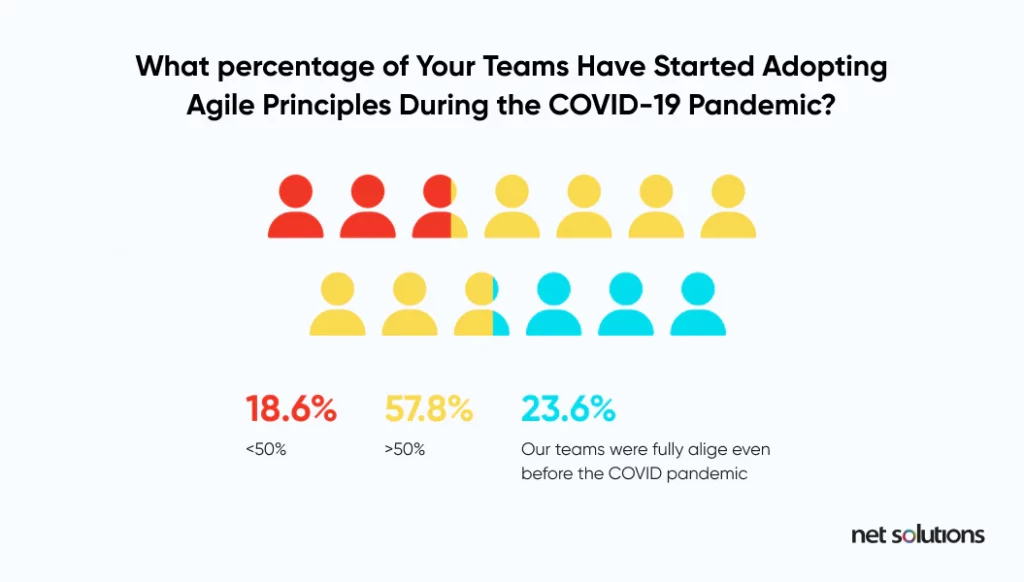
Agile transformation changes how organizations work and behave and thus helps contribute to change. This transformation aims to replace traditional operation models with a new approach. There are numerous paths to agility and start points; successful agile transformations share the elements described in this blog. To grasp agility, let’s begin with our understanding of Agile methodology.
What is Agile Methodology?
The Agile methodology is a method of project management that segregates a project into multiple phases. It entails ongoing collaboration with stakeholders and continuous improvement at each stage: agile methodology amalgams constant planning, proper execution, and frequent evaluations.
The agile method has several advantages, including increased customer satisfaction, decreased defect rates, and quicker development times.
Leading an organization-wide Agile transformation is difficult if you have long been comfortable with traditional methodologies. It will mean changes in running processes, people’s mindsets, technology, and organizational structure. These changes might be painstaking but will bring long-term benefits to your organization.
Here’s everything you need to understand about Agile Transformation and how to drive your organization toward this much-needed change.
What is Agile Transformation?
Agile transformation embraces change in the organization’s structure by applying the principles and values of the agile manifesto that, in turn, introduce flexibility, speed, collaboration, communication, and cross-functional setups.
Agile transformation is when individual team members naturally and consciously follow the values, principles, and Agile practices to complete the task rather than being forced or told to follow a path.
It is a holistic-level transformation that changes your approach toward developing and delivering projects. It is mainly around achieving business agility.
It is both about doing Agile and being agile in full swing.
Importance of Agile Transformation: Understand Your Why
Adopting Agile transformation for your company could catalyze your growth journey. It has proven results depending on how your company executes the agile processes.
Agility in an enterprise is the thoughtful scale-up of work practices across the entire company. For any company, the core plan around applying agile methodologies is strongly linked to the ability to create value. This agile journey can start with having a blueprint for your future strategies.
You can start by identifying the nodes – which element holds the most value for your company? Where is this agile methodology going to make a difference? So now, there are plenty of working models that contribute to agility. Figure out where the value is created – where could it be transformative?
Secondly, you can start by answering the questions, what are the working practices you will apply, and where?
This will help you identify the gaps, thereby devising and selecting the suitable agile transformation methodology for your company.
Agile Adoption vs. Agile Transformation
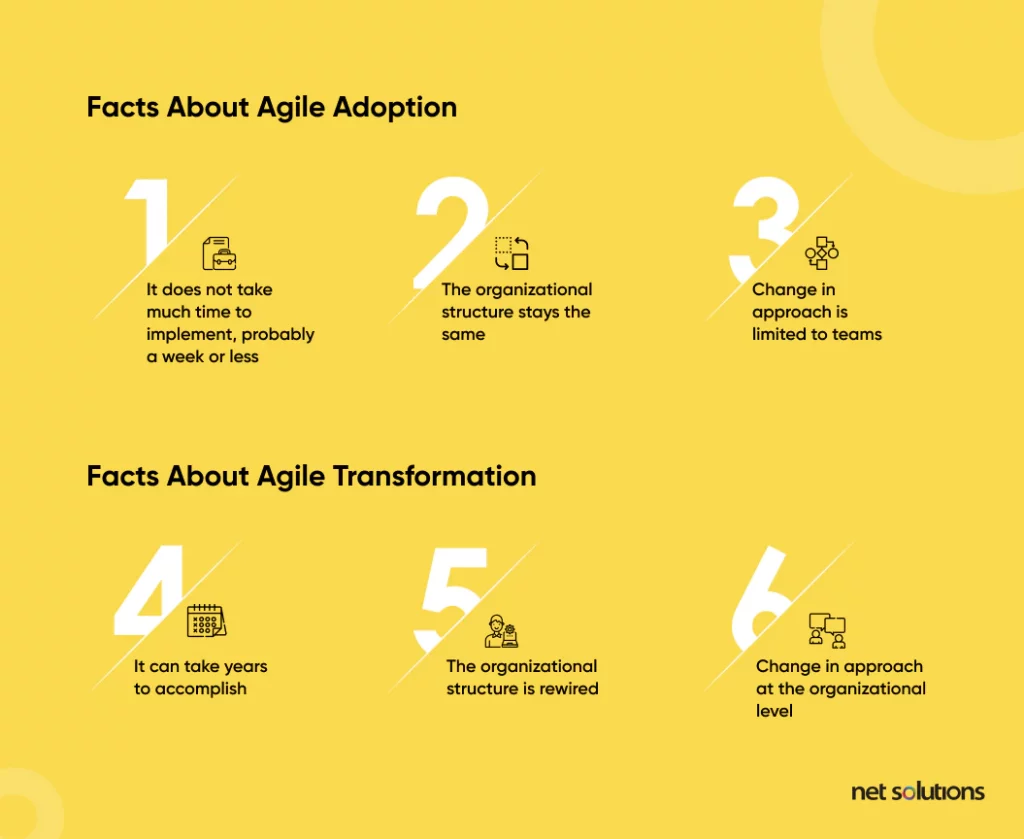
Organizations often confuse Agile adoption with Agile Transformation. Though they sound similar, they are entirely different from each other.
Adopting Agile implies adopting an Agile framework such as the agile-scrum and following the underlying process towards accomplishing the goal. It is about embracing different Agile practices to enable process change and improvement.
Facts about Agile Adoption:
- It does not take much time to implement, probably a week or less
- The organizational structure stays the same
- Change in approach is limited to teams
On the other hand, Agile transformation focuses on holistic change, i.e., embracing the Agile mindset and the processes followed to accomplish a task at hand. Agile transformation benefits originate both from doing Agile and being agile.
Facts about Agile transformation:
- It can take years to accomplish
- The organizational structure is rewired
- Change in approach at the organizational level

We respect your privacy. Your information is safe.
Agile Transformation vs. Digital Transformation
Agile transformation vs. digital transformation is widely discussed when it comes to aligning your business. Before implementing a business transformation for your company, you must understand the discussion around agile transformation vs. digital transformation. You can decide on the transformation that will operate your company and open up new possibilities for delivering new efficiency.
Agile transformation
introduces the improved technology implementation process. One of the vital components of the Agile Development methodology is scrum. Scrum is a robust and structured framework for continuous delivery, primarily focused on a team-based agile transformation approach to deliver value.
Here’s the workflow of scrum development:
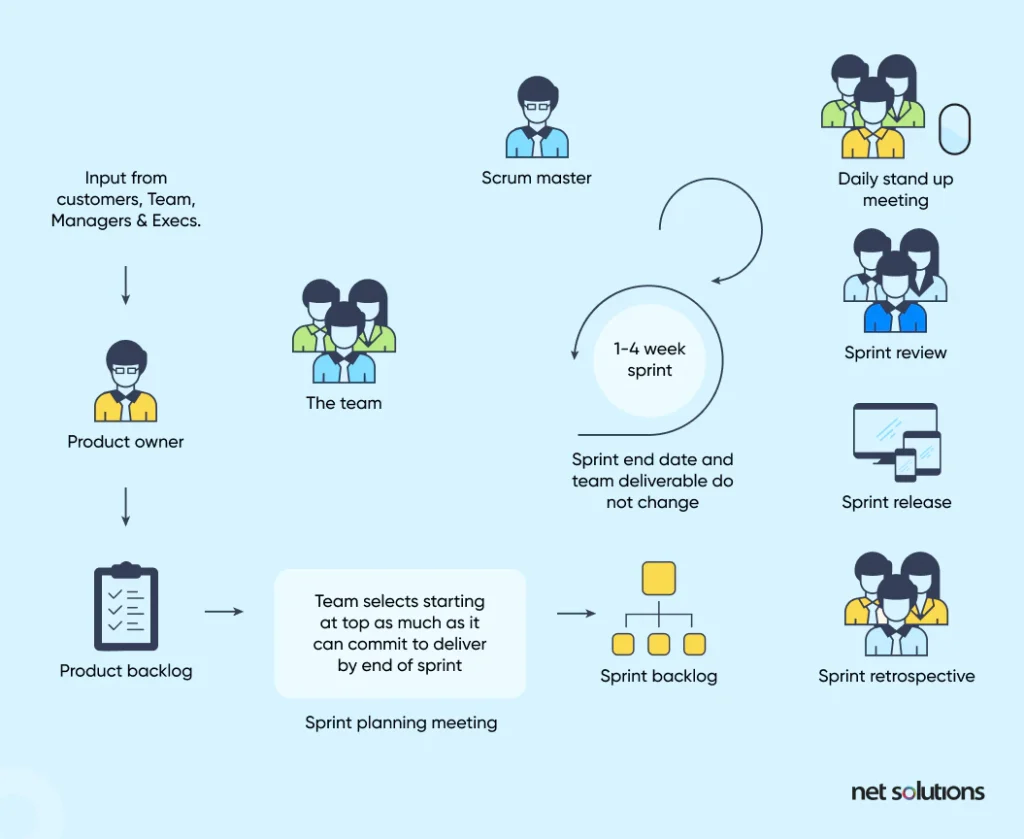
Digital Transformation
On the other hand, aims to embrace emerging technologies to gain a competitive advantage. It demands a thorough understanding of modern customers’ needs to rethink the entire business model with a strategic digital mindset.
The emerging technologies that will define digital transformation initiatives now and in the future include:
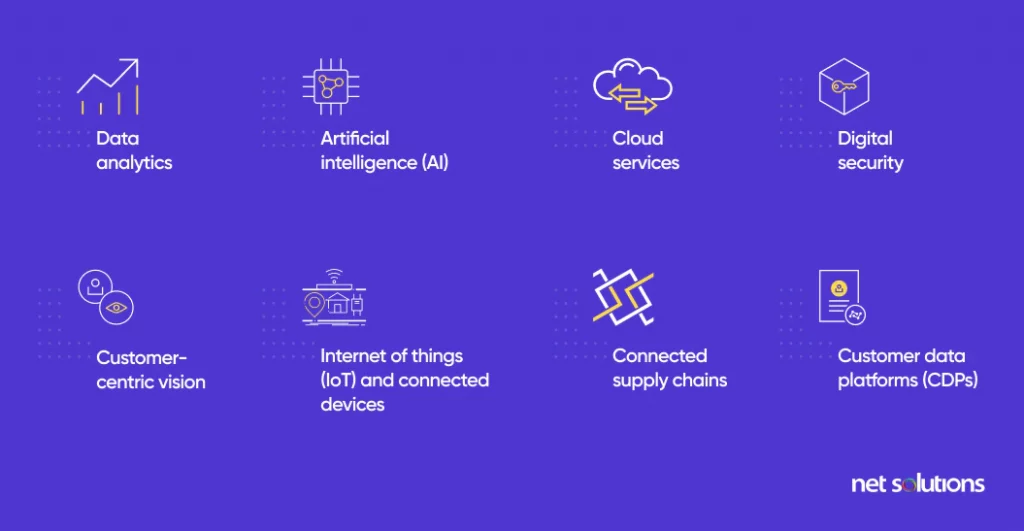
50.7% of leaders expect to invest in digital transformation initiatives to accelerate technology spending.— Digital Transformation Report 2020, Net Solutions
Agile and digital transformations are equally essential to drive your organization toward growth. Digital solutions allow businesses to automate operations and processes, enabling fundamental organizational changes and boosting client value.
What are the Major Benefits of Agile Transformation?
When on the road to agile transformation and beyond, you’ll witness more minor positive changes in the outcomes. Here are some of the agile transformation benefits that you can count on:
- Faster time to market, thus more flexibility in product delivery
- Preventing project-running errors because of efficient collaboration between development and testing
- Healthy organizational culture with much more independent and self-organizing employees
- Ability to incorporate changes without disrupting the entire product development cycle
- Synchronization and harmony among the product owner, the scrum master, and the development team
The Vital Stages of Agile Transformation
How do you start with agile transformation? Here are some aspects of the agile journey you need to be aware of:
1. Embracing Agile Mindset and Understanding Roles and Responsibilities
The first step for a full-swing Agile transformation should be addressing the organization’s existing siloed structures – Collaboration and communication are the pillars of Agile.
A leadership team is appointed that carries the responsibility to coach their respective teams and influence them towards embracing change. It is about embracing the agile mindset, i.e., self-organizing themselves to communicate and collaborate towards a common goal.
51% of senior executives mention ‘Leadership Mandate’ as the reason for an increase in their organization’s level of agility over the past five years.
A significant part of Agile transformation includes assigning roles and responsibilities to change the teams’ perspective. Here are some add-on tips to ensure a push toward an agile mindset:
- Running frequent meetings in the form of — standups, retrospectives, backlog refinements, etc.
- Strong leadership should be in place to ensure that teams follow the new path and no one sticks to the older ways of doing it. The leader must take on multiple roles and act as an enabler, a coach, a guide, and a catalyst.
- Set small, accomplishable goals and observe how each team member performs closely. This can help understand the loopholes and create strategies to fix them.
2. Agile Coaching
The second agile transformation step should be to appoint agile coaches to help spread awareness about the different agile frameworks and practices. Agile frameworks include — scrum, kanban, feature-driven development, crystal, etc.
On the other hand, understanding standard Agile practices are equally important. These include:
- Retrospectives: Analyzing past projects to infer lessons learned during product development.
- Sprints: Time-boxed period within which the development teams need to meet the pre-decided segments of the larger goal.
- User Stories and Epics: User stories in Agile imply the features covered in the product, and if the feature is significant, i.e., a large user story, it is called epic.
- Lead Time: The time spent between a requirement being raised and its fulfillment
- Minimum Viable Product (MVP): This is the basic version of the product launched in the market. The Minimum Viable Product (MVP) supports all the essential features that define the product or set it apart from the competition.
- Scrum Artifacts:The three scrum artifacts include — sprint backlog (list of tasks to be completed in a sprint), product backlog (new features or bug fixtures that need to be prioritized for following sprints), and burndown charts (work remaining in backlog).
An agile coach will ensure everyone learns the ropes of Agile Development and holistically implements the underlying practices. The coaches are also responsible for introducing the DevOps culture that binds closely with Agile. The cultural shift brings automation to the forefront, breaking the silos between development and operations.
If, in case, you want your digital product to get built on Agile methodology, skipping the Agile coaching step, try hiring an experienced Agile development company that can make sure that your product gets delivered at speed and scale.
3. Introduce Agile Tooling Stack
As remote work setups frame the new normal, the need to embrace Agile transformation has grown manifold. However, digital transformation is essential for constant communication and collaboration among distributed agile teams.
Here are some examples of remote stack products that can help thrive when on the road to Agile transformation:
|
Short-term Communication |
Slack, Microsoft Teams, Skype | |
|
Video Communication |
Zoom, Google Meet, Loom | |
|
Large-File Sharing |
Google Drive, Dropbox | |
|
Developer Tools |
Jira, GitHub, Tuple | |
|
Designer Collaboration Tools |
InVision, Figma, Marvel | |
|
Work Management Tools |
ClickUp, Trello | |
|
Data Management Tools |
Airtable, Notion | |
|
Virtual Collaboration |
Freehand by InVision, Miro and Mural, Basecamp | |
4. Building an Agile Transformation Roadmap
Knowing how to build an agile transformation roadmap is imperative for a successful transformation. A roadmap will help you set up goals and objectives and corresponding milestones that lie on the way. The elements of the Agile transformation roadmap will include:
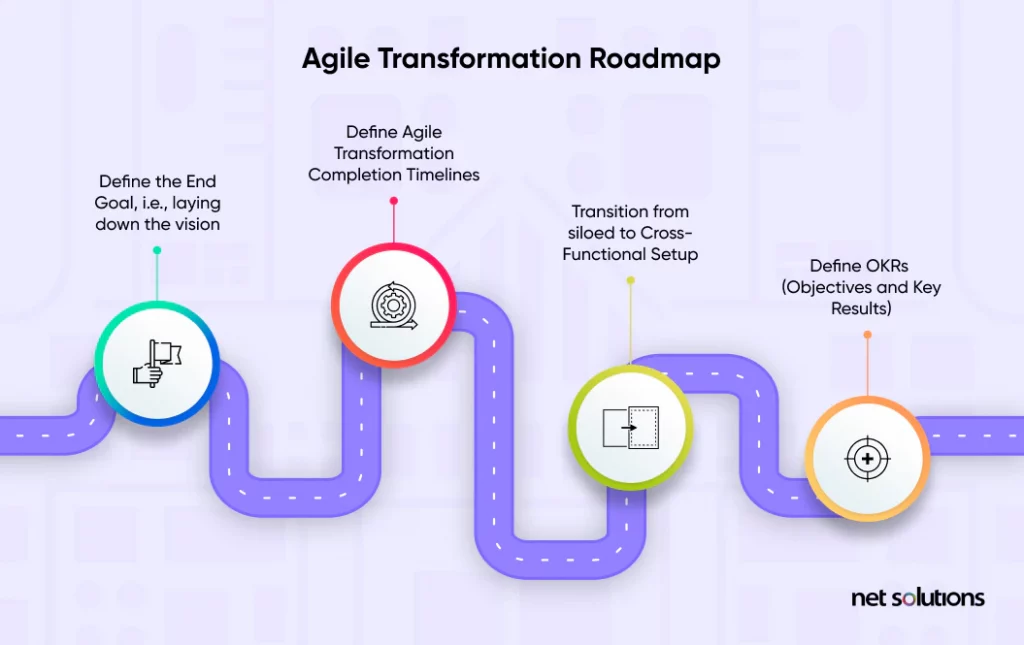
a. Establishing the End Goal, i.e., the Vision
Knowing where your organization stands (technologically and culturally) and where you see yourself in the coming times is a good practice.
This will help you set a vision and goals for the respective Agile transformation management. Here, your leadership skills come into play as you drive the teams safely toward transformation, and your vision will help guide the teams and understand the final achievable goal.
b. Timelines that lay down milestones and transformation achievable dates
Executives often ask, how long does an agile transformation take?
Here’s an answer — true transformation can take years to implement as it takes time to change how people think, perceive, and act. The ideal Agile transformation timeline should fall within 12-24 months.
You start with minor changes in the organization’s culture and software development practices and slowly and gradually move towards the bigger goals. The right way to accomplish this goal is to break larger goals into smaller achievable fragments so they can be implemented in a shorter time frame.
c. Setting up the Cross-Functional Setup — Who Will Do What
This roadmap aims to address functional silos and incorporate cross-functional setups where everyone works collaboratively towards a common goal. This is the biggest Agile transformation challenge, as resistance to change to how teams have been working for years is evident.
However, assigning roles and setting up a cross-functional setup is the starting point for the change. In this rewired setup, the designers, the architects, the developers, and the testers will work in tandem toward completing the task at hand.
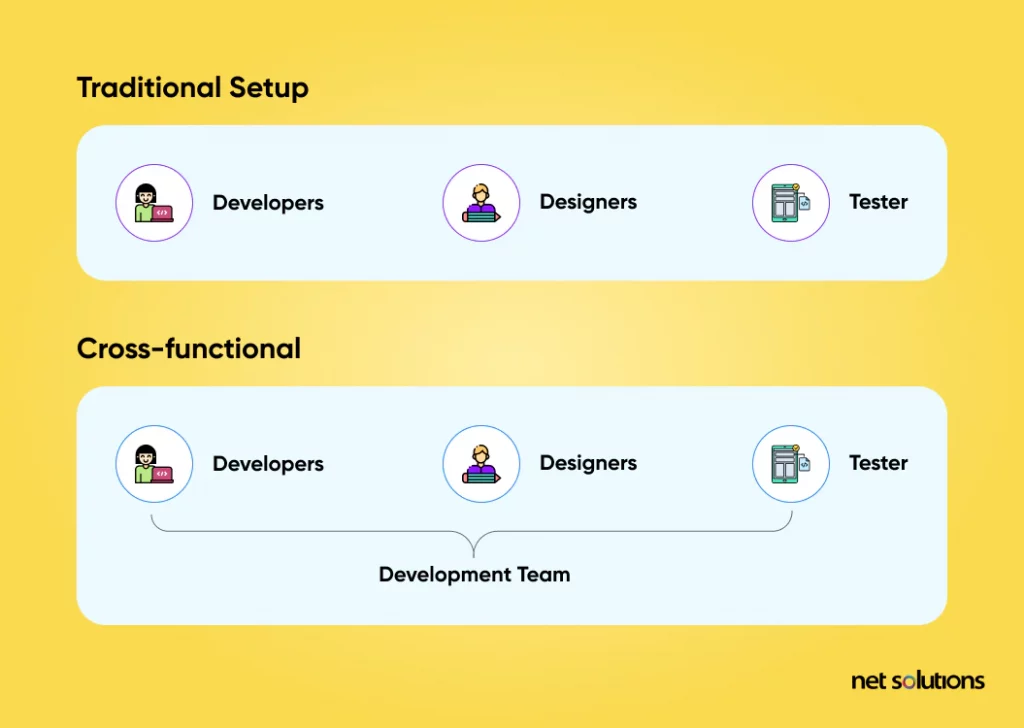
d. Define Objectives and Key Results (OKRs)
Laying down metrics for Agile transformation success should hold precedence as it helps track progress and rewire and reorganize the approach if the expectations are not being met.
OKRs play a significant role here when moving on the road to Agile Transformation. It helps build a result-focused culture as it helps lay down objectives and the corresponding metrics that measure success (based on objectives). That is, getting clear of your end goal and measuring your progress on the way to ensure you do not go off track.
“OKRs have helped lead us to 10x growth many times over.”— Larry Page, Google Co-Founder
There are two elements to OKRs, i.e.,
- What do we want to do, i.e., the objectives (primarily qualitative)
- The metrics that help track progress toward realizing the goals (quantitative principally)
Example of OKRs:
- Objective: Ensure faster time to market
- Key Results: Develop four user stories in a monthly sprint cycle, launch MVP in 90 days, WIP (Work in process) limit should be 6 (ideally — number of people in the team + 1)
High-level planning for incorporating Agile Coaching and consulting practices include:
- Who will do what — assigning the Agile roles
- Communication plan — for notifying all the teams about the progress status
5. Embracing the Product Mindset over the Project Mindset
Preferring a product mindset over a project mindset is another essential part of embracing Agile transformation thoroughly. Traditionally, organizations work on the project mindset, moving on with the next project and forgetting it once they deliver the working software to the client.
This is not a value that Agile promotes and how project management should be. Instead, to be tagged as an agile organization, embracing the product mindset should be considered — where continuous integration and delivery is given precedence. A product mindset means the Agile team maintains and delivers value throughout the software’s lifetime.
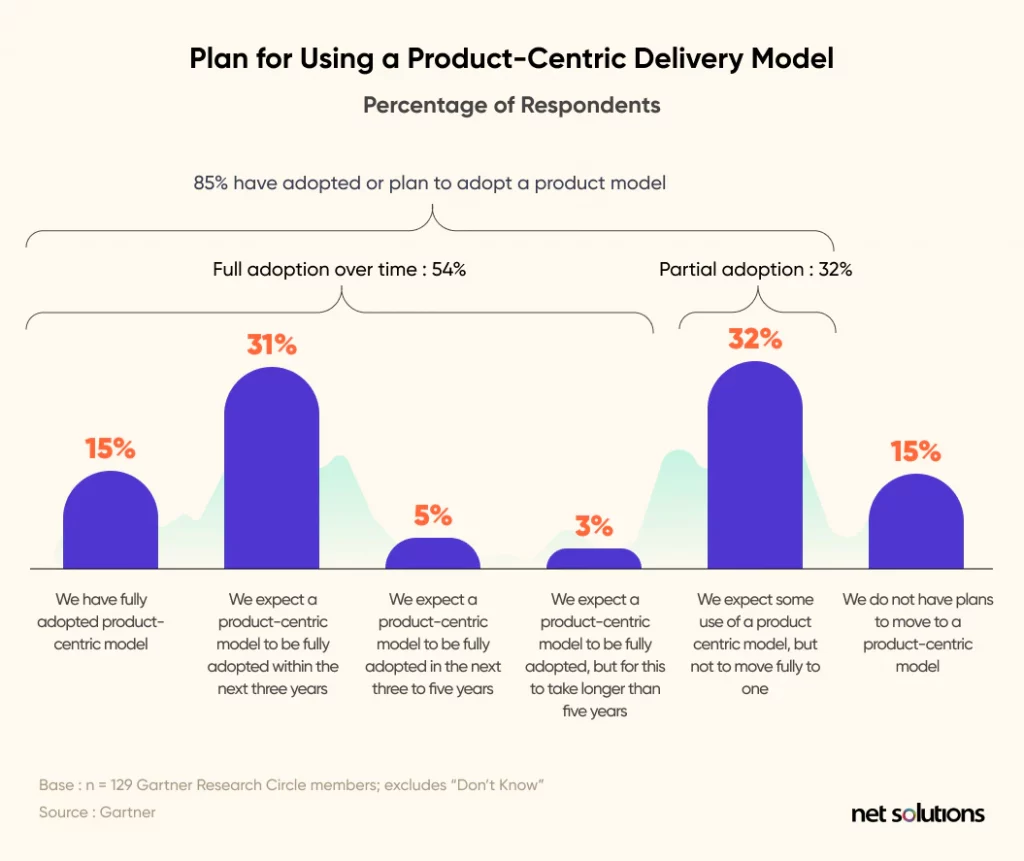
6. Test and Learn
You have a cross-functional team where everyone knows who does what, they have a fair understanding of Agile ways, Agile tools are in place, and the roadmap is being followed and tracked. What next? It is time to run some test sprints to ensure everything works out well, identify the impediments, if any, and fix them. Here’s all that the agile testing phase should focus on:
|
Test Sprints |
Running time-boxed sprint cycles that are characterized by a requirement that needs to be fulfilled | |
|
Daily Standups |
Daily meetings for the Agile Development team where they discuss:
What they did yesterday What are they planning to do today Any roadblocks that they discovered |
|
|
Retrospectives |
Running meetings where the team revisits old projects to identify their mistakes and learn from them | |
|
Prioritizing Product Backlog |
To put forward new feature requirements and changes to delivered feature and prioritize them accordingly | |
|
Setting WIP Limits |
Restricting the number of items that can exist in a sprint | |
On completing the sprint cycle, see how the entire process turns out. Identify impediments and other shortcomings and rework your agile transformation strategy for improvement. Being truly Agile is not the goal here; instead, the focus is on practicing and learning.
7. Validating your Agile Status
While many organizations claim to have transformed entirely, many are still “Agile in Name Only.”
More than 90% of senior executives prioritize becoming Agile, while less than 10% see their firm as currently highly Agile.— A survey by McKinsey & Deloitte
While you are on your road to Agile Transformation, do contemplate — are you moving in the right direction?
Here’s what a stalled agile transformation journey looks like:
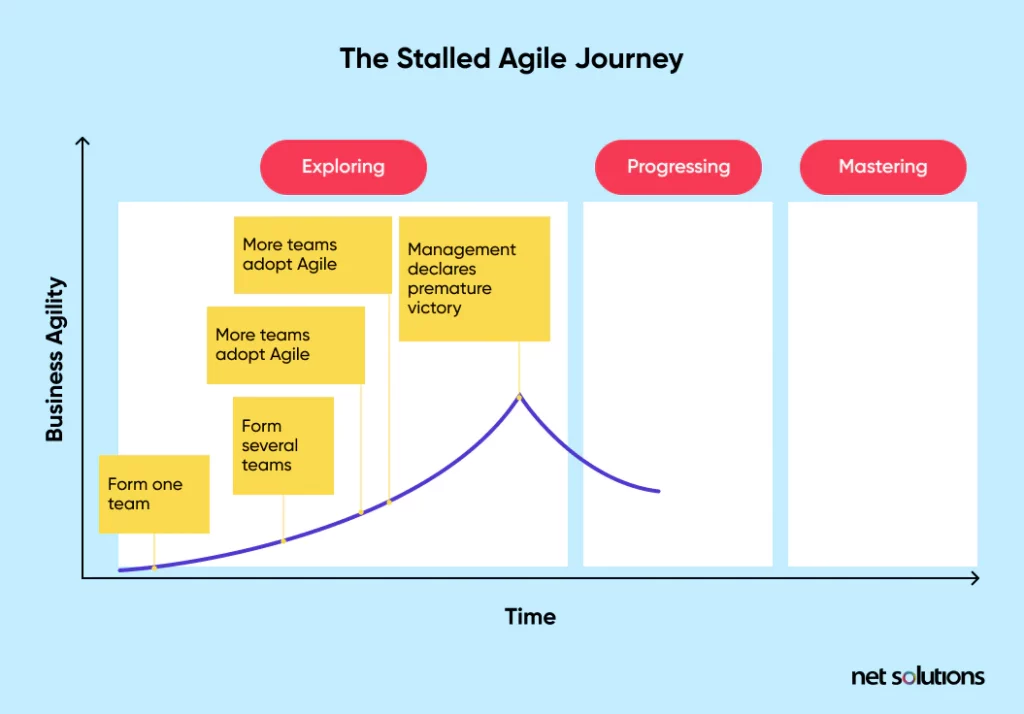
You can identify Agile In Name Only (AINO) from real Agile by looking at these factors:
- There is no ongoing communication with the end-users while transiting through the process of creating a product
- The organization has no feedback and shipping cadence loops
- Requirements are not precise at any phase of the Agile Software development life cycle
- The traditional development approach is still prevalent at some stage
If that is the case, rewire your Agile transformation strategy. Start with early-stage Agile, i.e., take baby steps towards the agile transformation approach. See how the small changes turn out and then slowly proceed towards making the whole transformation. Another way to manage the crisis is to seek agile transformation consulting to make meaningful and practical organization-wide changes.
Metrics for Measuring Agile Transformation Success
To have a genuinely accurate ROI, measure the benefits of agile using the following agile metrics at the start, mid-point, and end of the transformation.
- Cycle Time: This is the time taken to turn a request or requirement into delivered business value (production).
- Development Cycles: You can measure this by the time it takes from idea to solution and by how much the lead time has been shortened since the transition to Agile.
- Agile Maturity: It is the number of sprints consumed to deliver working and tested software products.
- Business Value: This metric showcases the number of user stories that the teams deliver over sprint cycles.
- Customer Satisfaction Rate: The agile maturity will lead to a positive impact on the customer with increased speed to market (reduced cycle time) and value delivery (early and continuous delivery of prioritized feature set).
What are the challenges to a successful Agile transformation?
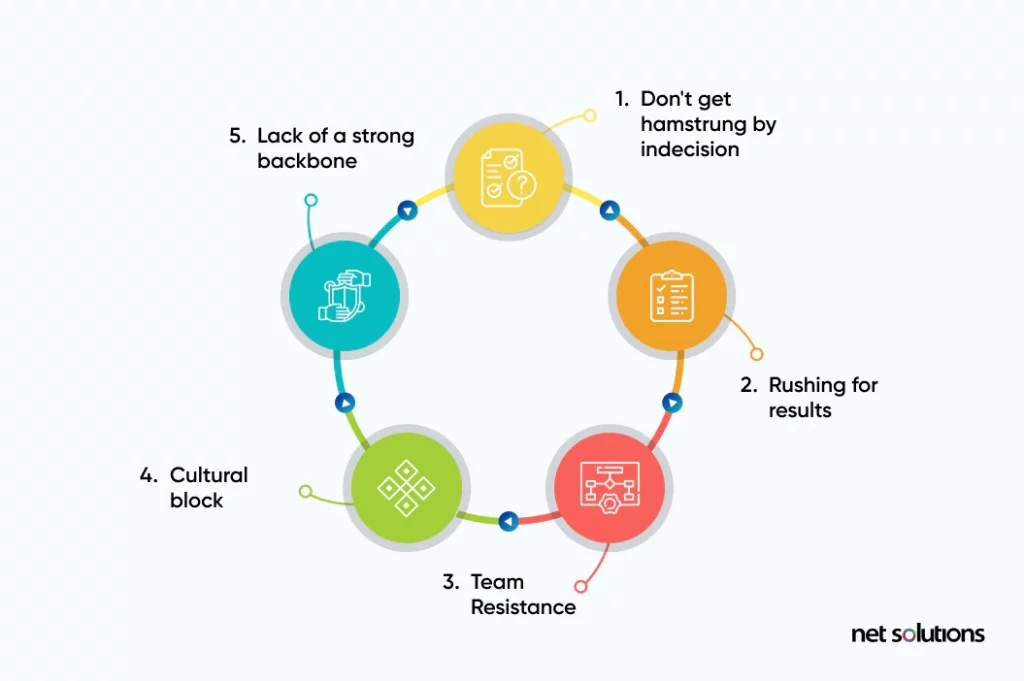
The road to a successful agile transformation comes with its challenges. The roadblocks that hinder the progress of enterprises in achieving their goals can be mitigated if executed effectively.
Here are the top 5 challenges that can delay your agile transformation journey:
1. Don’t get hamstrung by indecision:
Successful agile transformations require up-front planning and execution of strategies. Consider your organization’s readiness, resource, leadership bandwidth, and, as a result, the speed of the transformation, among other things.
Many people focusing on their organization’s Agile journey will be held back by indecision, mainly if the organization is not accustomed to quick action.
Try forming a rhythm with your teams to address this issue – filter what’s important and keep iterating. Keep your short and regular, preferably after every 1-2 weeks, so that the entire team works at the same pace.
2. Rushing for results:
Organizations often lack the strategy, understanding, and support systems to expand and hasten the transformation process. If there are resource constraints or a lack of leadership, organizations must consider whether they are ready to make this change.
A proper transformation should include a yearly plan that, over time, transforms an organization’s mindset, instigates cultural change, and involves implementing dedicated resources throughout the organization.
3. Team Resistance:
Train your employees to take complete responsibility for their work and fuel their talent. Taking complete ownership of the product will minimize the approval cycle and increase productivity at an individual level.
For many organizations, agile training is an afterthought of agile transformation. But it shouldn’t be the case.
4. Cultural block:
Successful transformations necessitate a change from the bottom up, at the level of the working team, and a change in how leaders operate and think, as this significantly impacts the organization’s culture.
The rigid application of scaled agile frameworks is one aspect that frequently limits experimentation. Too often, companies shift the focus of an agile transformation away from minimizing processes and changing mindsets and behaviors to enable innovation and put the proper framework in place.
While frameworks can help structure the transformation, it is critical not to be too rigid in their application and always consider how they can be adapted to meet the organization’s needs.
5. Lack of a strong backbone:
Agile is frequently used as a project management approach. It is critical to understand that using agile methodology requires changes to core management strategies that your employees can access, among other things. Without these changes to core management processes, teams may struggle to execute quickly, stifling innovation and increasing time to market, among other things.
How does Agile transformation deal with resistance?
Organizational resistance to change is not a new phenomenon, nor limited to agile transformations. It’s also unavoidable—any significant change in an organization is bound to elicit opposition from some people.
However, agile transformations are challenging because they necessitate a mindset shift rather than simply following a methodology. Agile coaches must encourage people to change not only how they work but also how they think about work. Here are a few pointers that will help –
- Listening to people and understanding their reasons for resisting change can help with all types of (process) improvement, not just agile. Rather than imposing change, invite them, engage them, and support them on their agile journey.
- Empathy is one of the practical tools for transforming resistance into an enabler of change. Most people want to be heard and understood when it comes to change, which would increase trust and the likelihood of people responding positively to change.
- Goals are an excellent catalyst for change, and continuous reflection at regular intervals becomes extremely valuable in achieving the goal. Teams may disagree on agile or a specific agile framework, but guiding them in understanding goals based on shared interests will help. Constructing this agreement with teams, customers, and leaders aids in raising awareness and driving change.
How can Agile Transformations be sustained?
Agile transformations tend to turn organizations enthusiastic and driven. However, agile transformations take time, and maintaining that energy level can be challenging. Support for the transformation begins to dwindle, people question it, and other programs get prioritized.
There are a few of the many activities you could undertake to ensure the sustainability of your agile transformation. You can sustain the effort required to complete your transformation by providing leadership support through a strong business case, bringing the entire organization on board with agile advocates, and optimizing agile teams with your scrum masters and coaches.
What is the Role of Leaders in a Successful Agile Transformation?
It’s all about the mindset.
Senior leaders must develop new mindsets and abilities to transform themselves, their teams, and the organization to build and lead an agile organization. Agile transformations necessitate three new sets of expertise for leaders.
They must first transform themselves to develop new personal mindsets and behaviors. Second, they must restructure their teams to work in innovative ways. Third, it is crucial to establish the abilities needed to transform the organization by incorporating agility into the structure and culture of the entire enterprise.
Consistency is the key here. Worry less about the time it takes for the transformation.
Frequently Asked Questions
An agile transformation roadmap is a visual method that directs a company through transitioning to an agile workflow for faster innovation and a better customer experience. The roadmap typically includes specific goals, success metrics, product vision, and initiatives to be undertaken by key team leaders.
- Specify a clear vision
- Form a leadership collaboration
- Design a transformation roadmap
- Keep a 3-months plan
- Adjust and understand
- Connect activities to results
- Deliver safety for all involved
Agile project management is a transformational method to project management that concentrates on continuous releases and integrating customer feedback with each iteration.
Examples of firms that already make the most using agile transformation are –
- BBVA
- JP Morgan Chase
- Sky
- Philips
- Vista Print



